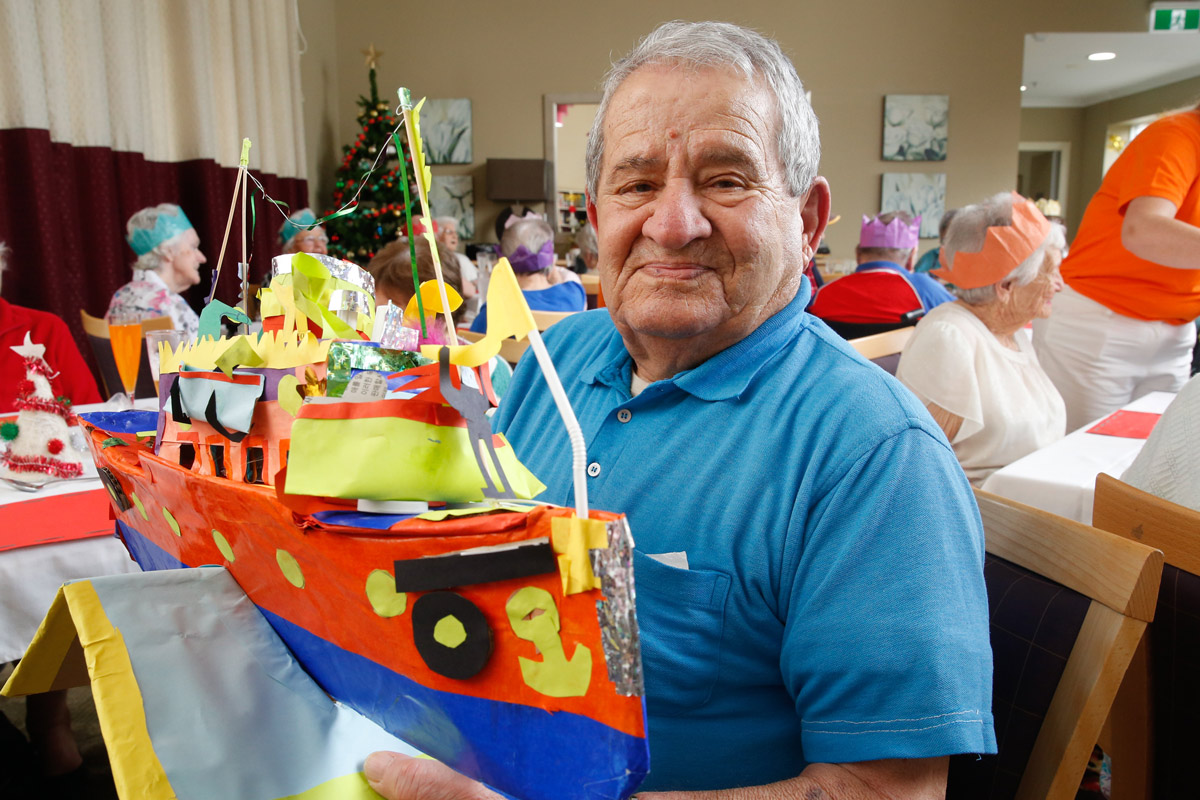What is Lewy body dementia?
Learn more about this common form of dementia, the signs and symptoms to look out for and how you can help manage this disease.

Lewy body dementia affects more than 100,000 Australians each year and is one of the most common forms of dementia. It is caused by the degeneration and death of nerve cells in the brain and, while both men and women can develop the disease, it’s more common in men.
Why is it called Lewy body dementia?
The name ‘Lewy body’ refers to the presence of abnormal spherical structures, called Lewy bodies, which develop inside nerve cells and are thought to contribute to brain cell death.
The disease is a type of progressive dementia due to the gradual brain damage that occurs when there is an unusual build-up of a protein called alpha-synuclein in brain cells. This can cause changes in movement, thinking and behaviour.
Lewy body dementia is similar to Alzheimer’s disease in many ways and in the past it has been difficult to distinguish the two. Only recently has it been accepted as a disease in its own right.
What's the difference between Lewy body dementia and Alzheimer's disease?
Lewy body dementia and Alzheimer's disease can appear similar in the early stages, and it is not uncommon for someone with Lewy body dementia to be mistakenly diagnosed with Alzheimer's at first.
The main differences between the two are as follows:
- Lewy body dementia is caused by abnormal deposits of proteins called Lewy bodies in the brain, whereas Alzheimer's disease is caused by the abnormal build-up of proteins called amyloid in the brain and the abnormal formation of a protein called tau that blocks nerve signals.
- Lewy body dementia symptoms typically appear around age 50 but can start earlier, whereas Alzheimer's symptoms typically appear around the mid-60s.
- Memory loss may occur in the later stages of Lewy body dementia, whereas for Alzheimer's disease it's usually one of the first noticeable symptoms.
- Alzheimer's affects the brain's ability to store new information in the form of memories, while Lewy body dementia targets a different set of cognitive functions - specifically problem-solving and reasoning.
Hallucinations occur early in Lewy body dementia but only after about four years in Alzheimer’s disease.
What causes Lewy body dementia?
At present, there is no known cause of Lewy body disease, and no known risk factors have been identified. There is also no evidence that it is an inherited disease.
You can learn more about a typical case of Lewy body disease by watching Dementia Australia’s three-part video series here. The videos features Robin Groves, who was diagnosed with Lewy body disease in 2006, and his wife Lis, and how it has affected their lives.

Forms of Lewy body dementia
According to Dementia Australia, Lewy body disease includes three overlapping disorders:
- Parkinson’s disease - which is diagnosed by the presence of significant movement symptoms including slowness, muscle stiffness and tremor.
- Parkinson’s disease dementia - which is diagnosed when a person develops dementia symptoms after having at least 12 months of established Parkinson’s disease. The progression from Parkinson’s disease to Parkinson’s disease dementia can be slow.
- Dementia with Lewy bodies - which is the presence of dementia symptoms at least 12 months before the development of the significant movement symptoms that are prominent in Parkinson’s disease. It's important to note that not everyone who has dementia with Lewy bodies will develop these symptoms, and not everyone will be diagnosed as having Parkinson’s disease.
What are the symptoms of Lewy body dementia?
The main symptoms of dementia with Lewy body disease include:
Difficulty with concentration and attention
- This includes not being able to stay focused on one thing for too long, easily getting distracted or losing interest quickly.
Extreme confusion
- This includes slurring words or having long pauses during speech, forgetting what a task is while it's being performed, sudden changes in emotion including sudden agitation, and incoherent speech.
Difficulties judging distance
- This includes having trouble perceiving the distance between two objects and can often result in trips or falls.
Issues with sleep
- Sleep disorders are common in people with Lewy body dementia, but are often undiagnosed. Some of the sleep-related disorders seen in people with Lewy body dementia may include:
- REM sleep behavior disorder
- Excessive daytime sleepiness where a person is sleeping two or more hours during the day
- Insomnia
Movement disorders
- Restless leg syndrome or other movement problems such as general restlessness, agitation or an inability to get settled.
Other symptoms of Lewy body dementia include significant changes to the nervous system that regulates automatic functions such as those of the heart, glands, and muscles. A person with lewy body dementia may therefore have problems with low blood pressure, changes in body temperature, dizziness, regular urinary incontinence and constipation, and a poor sense of smell.

Aged care services with IRT
IRT are the leaders in person-centred dementia care. Our innovative Journey of Care model enables us to tailor our dementia care environments, equipment and programs to meet the unique needs of residents living with dementia.
Find out moreDiagnosing Lewy body dementia
In order to officially diagnose Lewy body dementia, there must be a least two of the following fundamental symptoms present:
Visual hallucinations – this involves seeing things that aren’t there. For example, flashes of light, or more vivid visuals like seeing insects crawling on your hand or on the face of someone you know.
Parkinsonism – this involves tremors and a movement disorder that results in muscle rigidity and stiffness similar to that seen in Parkinson's disease.
Fluctuations in mental state – this is where a person may be lucid and clear at one time, then confused, disoriented and bewildered at other times. This fluctuation can occur over a period of hours, or even minutes.
How to support a person living with Lewy body dementia
A person living with dementia with Lewy body disease is often described as being in a muddle or in a state of confusion.
To help support a person living with this disease, the following tips may be helpful:
- Suggest a medical assessment if you recognise significant changes in behaviour. Diagnosing a person with Lewy body dementia in its early stages means that a plan can be put in place to help them better manage their symptoms.
- Encourage the person to ask for assistance and develop strategies to ensure important tasks are completed.
- Learn to recognise the person’s ‘good days’ and be flexible with arrangements on their ‘bad days.’
- Organise meals with just one or two friends or family rather than a large number so as to not overwhelm the person.
- Select outings where you have some control over noise levels and crowd control. Noisy settings can be distributing and result in the person becoming agitated or withdrawn.
- Encourage the person to attend important family celebrations for part of the time, rather than not go at all.
- Be patient and give the person plenty of time to interpret what is happening and respond.
- Speak directly – non-verbal gestures such as shoulder shrugs are difficult for a person with Lewy body disease to understand.
- Involve the person in decision making and important life choices.
- Ensure their home is uncluttered and safe, and remove any trip hazards such as unnecessary mats which could lead to a fall.
- Do not put unrealistic expectations on the person.
You may also like to consider advance care planning and ensuring legal documents such as powers of attorney and wills are in place.
Advance care planning gives you the opportunity to think about, discuss and record a person’s preferences for the type of care they’d like to receive and the outcomes they’d consider acceptable.
It usually involves preferences being documented in a plan known as an advance care directive, and the appointment of a substitute decision-maker to help ensure the person’s preferences are respected.
You can read more about advanced care planning here.
What treatments are available?
At this stage, there is no cure for Lewy body disease. However, some symptoms may be reduced by considering a comprehensive treatment plan in consultation with a GP or health professional.
Symptoms such as hallucinations may potentially be relieved by medication. However, medications to relieve hallucinations may increase other symptoms like muscle tremors and stiffness.
It’s always best to consult a health professional to determine what is best for your individual needs.
Remember, only a medical practitioner such as a doctor or specialist can diagnose dementia. If an official diagnosis has been made, there is a lot of support available to help you and your loved ones manage.
A good place to start is by visiting Dementia Australia’s website or by calling the National Dementia Helpline on 1800 100 500. They offer support, information, education and counselling.

Dementia care services with IRT
We offer personalised and compassionate dementia care in a secure environment to ensure you or your loved one feels safe, supported and empowered in our community. We offer various services to support a person living with dementia and our innovative Journey of Care model also enables us to tailor our dementia care environments, equipment and programs to meet the unique needs of residents living with dementia.
Find out moreYou may also like
50 purposeful activities for people living with dementia
For the estimated 447,000 Australians who live with dementia, it can be difficult to perform activities they may once have loved. Lack of stimulation and…
10 benefits of leisure and lifestyle activities in aged care
Learn how lifestyle activities in aged care support residents to live life to their full potential and discover some of the popular activities available.


